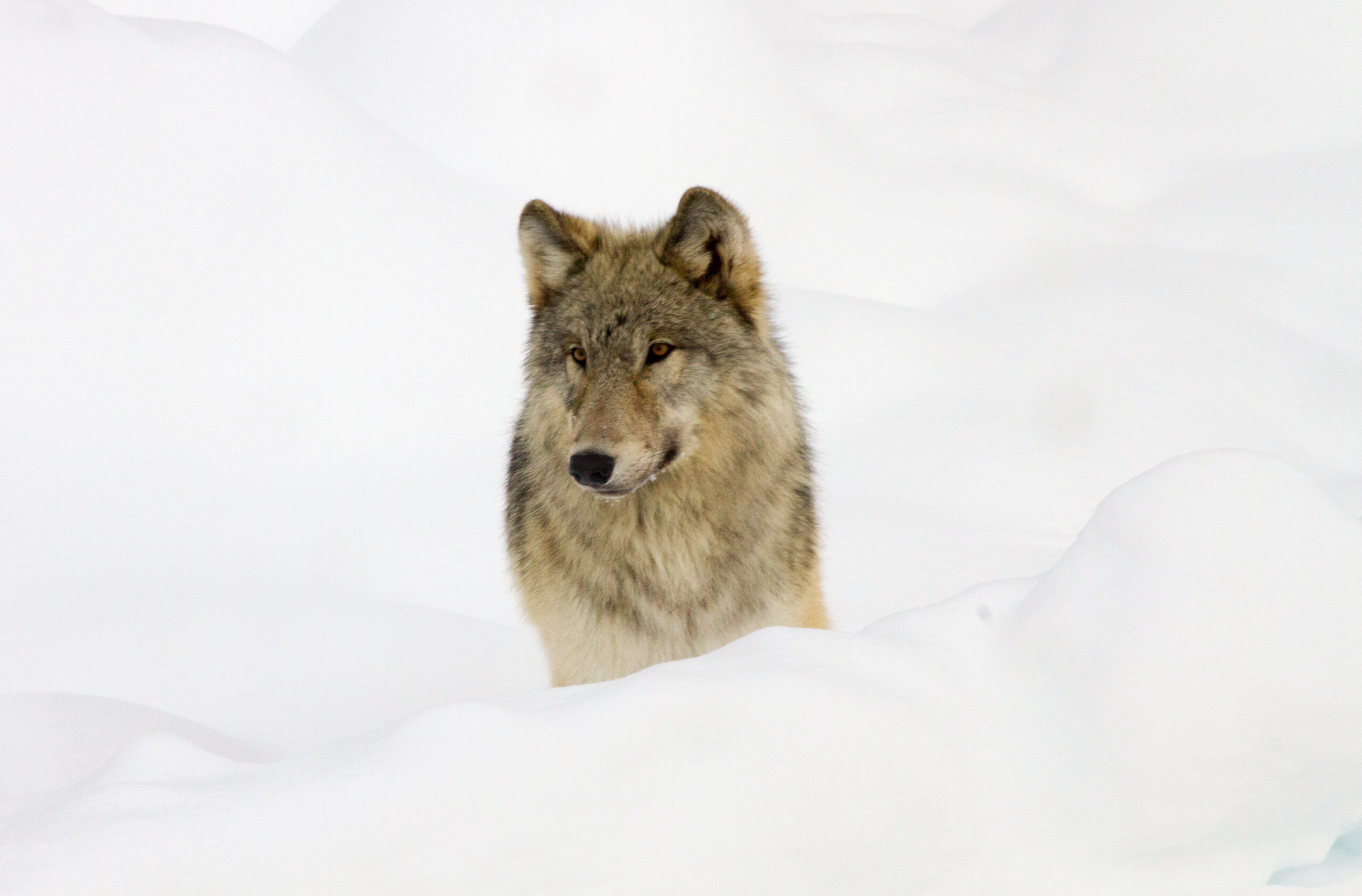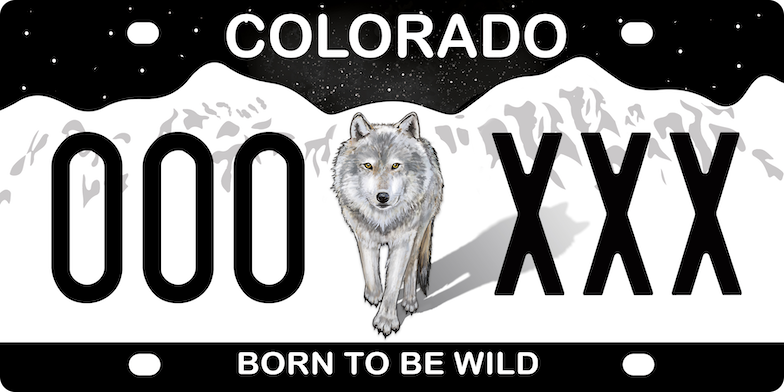The Vision
As the Colorado General Assembly completed the last day of the 2023 session, two bills are headed to the desk of Governor Jared Polis which will make Colorado a model of gray wolf conservation. HB23-1265 creates the beautiful new ‘Born to be Wild’ license plate that will support programs to prevent conflicts with gray wolves through non-lethal means. The other bill, SB23-255, creates a permanent appropriation to cover livestock losses to wolves.
Both bills are the result of unprecedented collaboration between wildlife conservationists, hunters and livestock producers.

Rocky Mountain Wolf Project aims to improve public understanding of gray wolf behavior, ecology, and options for re-establishing the species in Colorado. The benchmark of our success: Wolves again roaming the snow-capped peaks, rim rock canyons, and primeval forests of western Colorado.
We collaborate with individuals and organizations—from wildlife biologists to Colorado landowners to conservationists—dedicated to returning wolves to Colorado. We advocate for using the best available scientific data in all decision-making processes related to wolf restoration. The Rocky Mountain Wolf Project collaborates with a vast team of individuals and organizations to help guide our work.
The Rocky Mountain Wolf Project is a project of the Biophilia Foundation (Tax ID #52-2199334).
THE WOLF PLATE
Featuring a gray wolf against the classic Colorado mountain background, under a sky lit by the Milky Way, the plate was a graduate project for Gillian Marie, a scientific illustrator living on the Front Range. Marie collaborated with Rob Edward, his wife Anne, and other volunteers at the Rocky Mountain Wolf Project to develop the design.
Rocky Mountain Wolf Project proved the overwhelming support for the license plate with more than 4,500 people signing up to support the license plate within 72 hours. You can keep up to date with the progress by signing up today.

The ‘Born To Be Wild’ license plate will move hundreds of thousands of dollars annually to Colorado Parks & Wildlife to fund non-lethal conflict reduction programs and tools. The plate will also support research to make those tools more effective.
Rob Edward, Strategic Advisor for the Rocky Mountain Wolf Project states: “We are very proud of the plate that our volunteers created, and grateful for the support of livestock producers, hunters, the bill sponsors and the Polis Administration in securing legislative approval.”
Gary Skiba, Wildlife Program Manager at San Juan Citizens Alliance in Durango, states: “The Born to be Wild license plate is another demonstration of Colorado’s progressive approach to wolf restoration. Our thoughtful approach ensures that we can achieve true coexistence and avoid the conflicts seen in other states.”
The ‘Born to be Wild’ license plate will help to decrease demand from the compensation fund. Preventing conflict with wolves averts the need for loss compensation. Notably, keeping the focus on non-lethal conflict management also decreases the odds of future loss to wolves. Emerging scientific research suggests that wolf packs which experience human-caused loss are more prone to turn to killing livestock than packs that do not have members killed by humans.
HB23-1265
Funds from sales of the ‘Born to be Wild’ license plate shall be deposited into the Wildlife Cash Fund and are to be used for any of the following purposes related to the restoration and management of gray wolves pursuant to Section 33-2-105.8:
- Programs, training, personnel, contractors, and community outreach events related to nonlethal means of mitigating and preventing conflict with gray wolves;
- The purchase and deployment of equipment;
- Technology and training materials related to nonlethal means of mitigating and preventing conflict with gray wolves;
- To support research related to developing more effective tools, technology, and methods for mitigating and preventing conflict with gray wolves by nonlethal means;
- To support the observation, monitoring, and nonlethal management of gray wolf populations;
- For promotion of the “Born to be Wild” license plate, for which the division shall solicit grant applications annually from, and may award grants to, organizations in order to promote and market the “Born to be Wild” license plate;
or; - Other nonlethal means for reducing conflict with gray wolves, as determined by the Division.
The Division shall not use any money from fees paid pursuant to Section 42-3-367 (4)(a)(II) and deposited in the Wildlife Cash Fund for the lethal control of wolves or for compensation for wolf depredation.
The bill also provides for an appropriation, for the 2023-24 state fiscal year, of $548,000.00 to the Department of Natural Resources for use by the Division of Parks and Wildlife. This appropriation is from the Wildlife Cash Fund created in section 33-1-112 (1)(a), C.R.S. To implement this act, the department may use this appropriation for wildlife operations.
 Colorado Parks and Wildlife (CPW) is charged with balancing the conservation of our wildlife and habitat with the recreational needs of our state. The Future Generations Act passed in 2018 provides specific goals designed to help CPW achieve that balance. CPW’s agency mission is critical and relevant to all Coloradans, and we need the support of all Coloradans in fulfilling this critical work.
Colorado Parks and Wildlife (CPW) is charged with balancing the conservation of our wildlife and habitat with the recreational needs of our state. The Future Generations Act passed in 2018 provides specific goals designed to help CPW achieve that balance. CPW’s agency mission is critical and relevant to all Coloradans, and we need the support of all Coloradans in fulfilling this critical work.
Colorado Parks and Wildlife’s conservation teams aim to nurture healthy landscapes and coexistence between humans and wildlife for generations to come. Through proactive monitoring and surveying, we keep tabs on all species, both those in trouble and those thriving. Preventing endangerment includes careful land use, in-depth research, and cooperative partnerships.
The agency’s proactive approach allows for consideration of all interests and motivations. Planning ahead leaves more room to protect wildlife while maximizing economic opportunities for landowners and industries throughout the state.
Our State Wildlife Action Plan is the guiding document for the conservation teams and for Colorado Parks and Wildlife as a whole as we strive to make all decisions with conservation in mind. It details our greatest conservation needs.
Our highest priority projects aim to mitigate damages to high-risk species and the habitats they rely on. By balancing species-specific needs with policy requirements and broad, habitat-based projects, we can effectively manage all of Colorado’s wildlife. Our comprehensive methods have already seen huge successes, like keeping the Greater Sage-Grouse off of the endangered species list.
We rely on you to help us spread the word, participate in citizen science, and contribute to our resource base. Help us protect the landscapes and animals that make Colorado so spectacular.
CPW’s mission is to perpetuate the wildlife resources of the state, to provide a quality state parks system, and to provide enjoyable and sustainable outdoor recreation opportunities that educate and inspire current and future generations to serve as active stewards of Colorado’s natural resources.
Guided by our conservation principles, this mission encompasses all of CPW’s work — from managing Colorado’s 960 species of wildlife to its more than state parks and more than 350 wildlife areas covering approximately 900,000 acres, as well as management of fishing and hunting, wildlife watching, camping, motorized and non-motorized trails, boating and outdoor education.
The opportunities offered by Colorado’s outdoors are almost endless but need to be carefully managed in order to protect our natural resources both now and for future generations.
Colorado Parks and Wildlife is not a 501(c)(3) organization. CPW is a state agency, which has been granted legislative authority to accept and spend gifts and donations from individuals and organizations. See §§ 33-1-105(1)(f)(I)(A), 33-10-107(1)(e)(I)(A), C.R.S. CPW will use donated funds for exclusively public purposes as outlined in the federal Internal Revenue Code, 26 U.S.C. § 170(b)(1)(A)(v), 170(c)(1).
Colorado Parks and Wildlife is a state government agency with “enterprise status,” meaning CPW generates more than 90% of its annual funding from sources other than taxes or the state’s general fund. CPW relies primarily on license sales, state parks fees, and registration fees to support its operations and mission.
The governor-appointed group that oversees CPW is the Colorado Parks and Wildlife Commission. The Colorado Parks and Wildlife Commission is a citizen board, appointed by the Governor, which sets regulations and policies for Colorado’s state parks and wildlife programs.
The 11 voting members of the commission include three members who are sportspersons, one of whom must be an outfitter; three agricultural producers; three recreationalists, including one from a non-profit, non-consumptive wildlife organization; two at-large members. Members are expected to represent all parks and wildlife-related issues, regardless of their affiliation. A minimum of four commissioners must be from west of the Continental Divide.
The Executive Director of the Department of Natural Resources and the Commissioner of Agriculture also serve on the commission as ex-officio members.


